
Environmental Factor, December 2008, National Institute of Environmental Health Sciences
NIA Director Visits RTP to Address Students
By Eddy Ball
December 2008
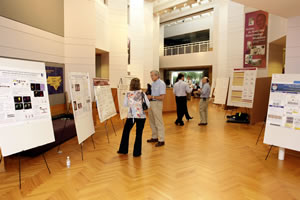
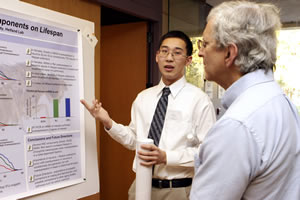

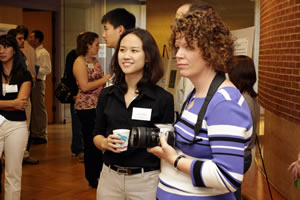
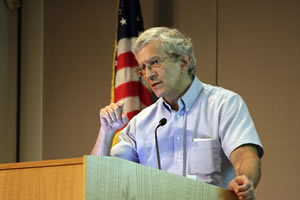
National Institute on Aging (NIA) Director Richard Hodes, M.D., was the keynote speaker at the 2008 Symposium on the Biology of Aging initiated by the American Foundation for Aging Research (AFAR) and the North Carolina GlaxoSmithKline Foundation. The symposium was held November 8 at the North Carolina Biotechnology Center in Research Triangle Park. Hodes’ (http://www.nia.nih.gov/AboutNIA/DirectorsPages/) ![]() talk on “Challenges and Opportunities in Aging Research” concluded a full-day agenda of platform and poster presentations by AFAR awardees from universities throughout the US.
talk on “Challenges and Opportunities in Aging Research” concluded a full-day agenda of platform and poster presentations by AFAR awardees from universities throughout the US.
The symposium enjoys generous support from the North Carolina GlaxoSmithKline Foundation, as well as from NIEHS, the North Carolina Biotechnology Center and Whole Foods of Raleigh. Contributions from these and other supporters and individuals contributing through the Combined Federal Campaign have allowed AFAR to distribute hundreds of thousands of dollars in fellowships over the last thirty years to the next generation of researchers studying aging and age-related health problems.
Beginning with an overview of the demography of aging as a framework for the challenges facing scientists and practitioners, Hodes pointed to “a very steep increase of people over 65, particularly those 85 or older.” For what is certainly the first time in history, he continued, “somewhere around the middle of the next decade, there are going to be more older adults than there are young [under five years old] kids.”
Commenting on “the nearly unbelievable demographic trends” and the “concern on the part of many” about the impact of increased longevity on quality of life (QOL), Hodes nevertheless found some reason for optimism in data on long-term care. Studies comparing the estimated increase in disability among older people, based on trends in 1982, have shown a surprising decline in the rate of disability, which is down from a projected 10 million to 7.5 million people currently.
Hodes observed that “the challenge that this creates, of course, is to understand just what are some of the factors that caused this [decline]” and to maintain this trend in the face of rising rates of obesity and diabetes. He turned to examples of significant recent epidemiological and biochemical investigations in the field. These include a large-scale study that demonstrated the efficacy of lifestyle changes, as compared to preventive medications, in preventing diabetes — even among the oldest groups enrolled — and studies of the relationships of caloric restriction, social interaction, the compound resveratrol, which is found in wines and berries, and familial determinants to QOL and longevity.
When Hodes, who maintains an active research program in the areas of cellular and molecular immunology and the biology of telomerase, turned to preliminary studies and speculation about ways to manipulate the “mitotic clock” that regulates the body’s progress to cellular senescence, the students were ready with questions. These ranged from queries about the development of epigenetic mapping for understanding how cancer genes are controlled to efforts to manipulate the expression of telomerase — the enzyme that determines the replicative capacity of cells — to prolong healthy cell viability and control cancer cell proliferation.
Hodes concluded his talk with a sobering reflection on current trends in NIH funding that have resulted in a marked decline in real dollars since the end of steady funding increases in 2003. Asserting that “you are the group that we’re all most interested in supporting,” he reinforced the commitment of NIH to supporting young investigators to the greatest extent possible with diminishing resources. He also expressed his hope that a growing older population will press for increased support of research that affects them so directly.
Founded in 1979, AFAR (http://www.ncsu.edu/project/afar/about_AFAR.htm) ![]() is recognized by the IRS as a national charity and describes itself as “the only organization supporting education and research in aging through fellowships to graduate and undergraduate students.” It has been awarded the Independent Charities Seal of Excellence for its exceptional standards of public accountability, program effectiveness and cost effectiveness.
is recognized by the IRS as a national charity and describes itself as “the only organization supporting education and research in aging through fellowships to graduate and undergraduate students.” It has been awarded the Independent Charities Seal of Excellence for its exceptional standards of public accountability, program effectiveness and cost effectiveness.
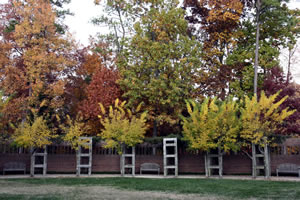
"Sixth Annual Science..." - previous story ![]()
![]() next story - "Fibroids and the..."
next story - "Fibroids and the..."
December 2008 Cover Page



